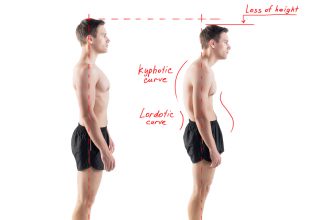Are you hunched over looking down at your screen right now?
 How Poor Posture Happens
How Poor Posture Happens
Poor posture is easy, whereas adapting habits of good posture often requires conscious effort. Most people do not think about their posture until someone (or something) brings it to their attention; such as pain and discomfort. The benefits of good posture far outweigh poor posture.
You could say that poor posture habits have followed trends in society. Children carry heavy backpacks, and many people spend hours hunched over a computer screen at work or at home.
Poor posture is not only a bad habit, but it can lead to back pain, neck pain, headaches and disc problems.
Change takes willpower. However, the rewards of good posture are well worth the effort. You will feel great, and you will look taller and appear more confident!
 What does good posture look like?
What does good posture look like?
Good posture looks something like this. The ears, shoulders, hips, knees and ankles align in a straight line. If you hung an imaginary plumb line from the earlobe, the line would hang straight through the middle of the anklebone.
Good posture means there is musculoskeletal balance. This balance helps to protect the joints in the spine from excessive stress. Good posture also guards against injury and possible deformity, and it can even help prevent back pain and neck pain.
Starting your day
- Stand up and stretch your arms above your head!
- Exercise regularly to keep the abdominal muscles strong—strong abs help support the spine.
- Avoid wearing high heels. Choose shoes that are comfortable and that offer good foot support.
- Look at yourself in the mirror. Is your posture good? Think about your posture and how to maintain it throughout your everyday activities.
Purses, backpacks, and briefcases
Carry only the essential items that are required for your day.
Avoid wearing a heavy purse or bag over one shoulder. This can place too much weight on one side of the body and can cause neck, shoulder, and back pain. Instead, use a bag or briefcase with a single strap, make sure the strap is padded and wide. Chiropractors suggests wearing a strap that is long enough to place over the head resting on the opposite side of the bag or briefcase. This can help to distribute the weight more evenly.
Some children carry almost as much weight in their backpack as they weigh! A heavy backpack should not exceed 15% of your body’s weight and certainly never more than 11 kilograms!
 Five simple tips for wearing a backpack
Five simple tips for wearing a backpack
- Pack the heaviest items closest to the spine.
- Make sure to do all the zips up.
- Secure the sternum, waist and compression straps.
- Always use both shoulder straps.
- Don’t wear the backpack below the hollow of the lower back.
Posture-friendly tips for working at your desk
- Choose office furniture that is ergonomically designed and that fits your body.
- Sit with your back against the back of the chair with knees at hip level. Consider using a foot rest. A small pillow or rolled towel placed at the lower back can offer needed support.
- Your workstation or desk should be at elbow height. Adjust chair height to meet this need.
- Sit with your shoulders straight and parallel to the hips.
- Don’t slouch or lean over your computer monitor. Either move closer to the work or move the work closer to you. Tilt the monitor so the center of the screen is at eye level for easy viewing.
- Don’t cradle the phone between your head and shoulder! It is much better to use the speaker phone or hold the phone in your hand.
- Get up, walk tall, and stretch often!
Going to sleep
A firm mattress will help keep your spine aligned! However, a few other tips to maintain great posture during sleep include:
- Don’t sleep on your stomach. Sleep on your side or back.
- When lying on your back, place a pillow under your knees. This will ease low back tension.
- When lying on your side, place a pillow between slightly bent knees. This will help keep the spine straight.
- Although oversize cushy pillows are inviting, they do not benefit your spine. Instead, use a pillow that allows your head to align with the rest of your body.

70 years of
Experience & Practice
Discovering & treating the cause of your problems
Increase your function & be the best version of you
Our Services

Chiropractic
A health care profession concerned with the diagnosis, treatment and prevention of disorders of the neuromusculoskeletal system and the effects of these disorders on general health. There is an emphasis on manual techniques, including joint adjustment and/or manipulation with a particular focus on subluxations.

Remedial Massage
If you have particular muscle tension or chronic pain a remedial massage may be for you. Your remedial massage therapist will assess where you need treatment and what may be causing your pain. They’ll perform some tests to see exactly which muscles are giving you trouble and will tailor a treatment plan to suit.
Feel Better Today - $49 Health Check-Up
Come in for your Discovery Process to find out what are the causes of your symptoms.
Includes:
- Thorough consultation
- X-Rays
- Explanation of results
- Digital Postural Assessment

 Five simple tips for wearing a backpack
Five simple tips for wearing a backpack